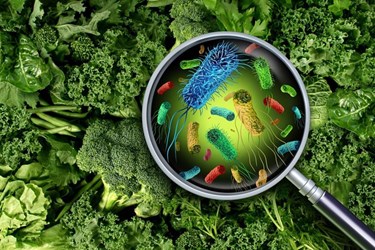Agricultural photonics sensor able to spot bacteria on fruit & veg

Research has found that pesticides in fruit and vegetables are killing up to 11,000 people every year and unintentionally poison up to 385 million worldwide.
The monitoring of foods for microscopic chemicals and harmful bacteria can take days and involves sending small batches off to laboratories for testing and analysis. Now a new detector is under development that will be able to spot minute traces of poisonous elements with photonics to give a result in a matter of minutes.
The ultrasensitive detector harnesses light particles to spot the tiniest traces of pesticide or bacteria 50 to 100 times quicker than existing technologies.
Currently being developed by an EU-funded consortium, the system will allow workers to check for pesticides or bacteria by monitoring dozens more samples of fruits and vegetables than are currently performed. From preparing a sample to detection, the new system can deliver a result in less than 30 minutes – a fraction of the time at present.
The team are using an extremely sensitive system that uses laser light to detect chemical or biological analytes. Called a plasmo-photonic bimodal multiplexing sensor, the system can spot bacteria or pesticides label-free, without having to use chemicals or dyes as a marker.
Given that food can degrade quickly and with lengthy safety checks at present, factories can often make fewer checks meaning consumers face a greater risk of exposure to poisons and bacteria – even in countries with very efficient monitoring techniques.
Safety checks involving fruit and vegetables are often made in random batches then sent to a laboratory, a process that can take days. Due to time and costs, these checks cannot be performed in critical parts of the value chain like supermarkets and restaurants.
Each year, 385 million people are unintentionally poisoned by eating fruit or vegetables that contain pesticides and thousands not only die, but when consumed via food and water these pesticides can cause a host of deadly long-term conditions, including birth defects, cancers, genetic defects, blood disorders, and neurotoxicity.
The project, called GRACED, is currently being coordinated by CyRIC – Cyprus research and innovation Centre, Cyprus and includes a consortium of experts from all across Europe. The developers took their inspiration from one of their existing sensors that examines water to detect microbiological or chemical contamination with a small number of pesticides.
The project, called GRACED, is currently being coordinated by CyRIC – the Cyprus research and innovation Centre, and includes a consortium of experts from all across Europe.
The system works by looking at the ‘binding’ of the contaminant to the sensor surface – producing a new unique signal when a harmful constituent is present.
With their plasmo-photonic bimodal multiplexing sensor, the GRACED team uses one of the most sensitive detection technologies available to identify at the molecular level.
Since the receptors on the sensor surface are specifically ‘tuned’ to a particular bacteria or chemical, only the analytes of interest are captured along the sensor.
Light travelling in the sensor generates a fully exposed evanescent field over the sensor surface and receptors are able to recognise the contaminants when a sample passes through due to changes in the speed of the laser light and therefore the interference pattern at the output.
This change can be measured and determined precisely against a set of existing values – and should be able to give an instant diagnosis for a contaminant expected at the picomolar to attomolar (pM–aM) range without any need for amplification.
The GRACED team sees the applications as being extremely useful to several next-generation food production alternatives.
“Vertical or urban farms are like a bit like a laboratory where everything is conducted in controlled rooms. Controlling the water quality is very important to the success of these types of farms, and if this process is automated, it is even better,” said Project coordinator Alessandro Giusti.
“Some urban farms are using ‘grey water’ – sink water used for irrigation – where the risk of contamination is possible. So, a solution like ours will be highly complementary to futuristic food production.”
Concluding in 2024, the GRACED project will conduct future trials in France, Italy, and Hungary, covering different types of production systems (conventional open-air farming, novel urban farming, short agroecological value chain, semi-automatic farming).